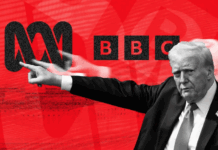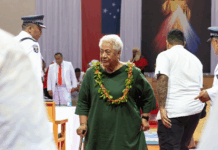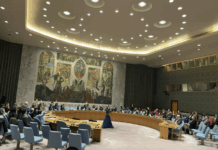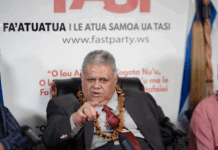The University of the South Pacific’s environmental centre spearheading climate change research believes in working together for shared solutions, says Professor Elisabeth Holland. Video: Pacific Media Centre’s Bearing Witness project
INTERVIEW: Lars Ursin of 2°C talks to Elisabeth Holland
The Pacific Islands are already struggling with the consequences of climate change. But they are not giving in. Instead, they have become a force to be reckoned with in international climate diplomacy. How did that happen?
2°C: How are the Pacific Islands experiencing the effects of global warming today?
Elisabeth Holland: Tropical cyclone Winston’s 40-metre waves, that is one thing. The devastating peak winds of both tropical cyclones Pam and Winston, and the destructive storm surges they brought. The fact that recovery after Winston amounted to 30 percent of Fiji’s GDP. Also in Fiji, 676 of around 1800 villages have already said they need to move. Not just from storm surges, but from repeated inundation due to rising sea level or changing storm patterns. Or coastal erosion generated by storm surges and rising sea levels.
In Fiji, we now recommend that all newly married couples move to higher ground. This is because it is tradition to build new housing for newlyweds to give the communities a head start on the inevitable transition. The transitions needs to happen in a methodical, well-organised way with community buy-in.
What areas of the Pacific Islands are most vulnerable to further climate change?
That would be Tuvalu, Kiribati, The Republic of the Marshall Islands and Tokelau. What they have in common, is a maximum elevation of 3 metres. They are along with the Maldives part of what is called the Coalition of Low Lying Atoll Nations on Climate Change.
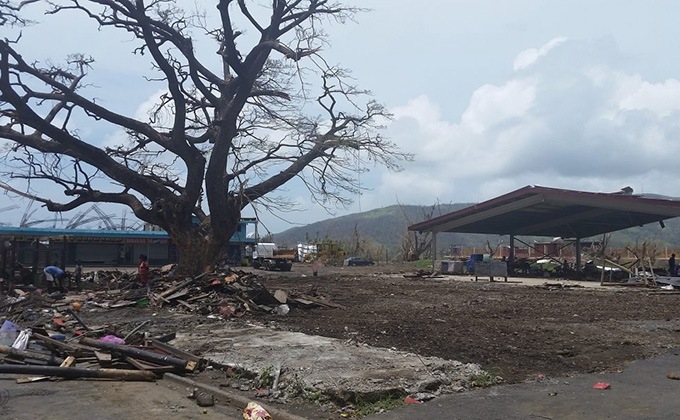
What is the outlook for the people living on these islands?
The new government of New Zealand is considering setting new immigration policy for their Pacific Island neighbours. Fiji is the only country which has said it would receive climate displaced refugees from the Pacific. Three countries, The Federated States of Micronesia, The Marshall Islands and Palau are part of the Compact of Free Association with the United States and eligible for US passports giving them the right to live, work and study in the USA. Migration, already underway, is to Hawai’i where the provision of some basic services can discriminate against people from these areas.
What practical measures are taken to prevent escalating damage?
There are several issues. Most important is what communities need today to be vibrant and healthy: Fresh water. So, for example, we have provided water tanks and reticulated water systems for more than 12.000 people, funded by the EU. Many of the Pacific Island countries have just begun to access the Green Climate Fund. Tuvalu residents refuse to leave, they say they will adapt. Their funds will be focused on coastal stabilisation, such as sea walls. Marshall Islands are considering which islands to sacrifice to protect the remaining islands. Tokelau has just gotten green climate funding. They are making similar decisions.
‘Migration with dignity’
And Kiribati, under president Anote Tong, a vocal climate spokesperson, has advocated “migration with dignity”. He is focused on ensuring that his population is as well-educated as possible, while at same time taking adaptative measures. Tokelau, by the way, claims to be the first 100 percent renewable energy country, under a project funded by New Zealand.
At the Paris negotiations, you were ringside when the Pacific Islands announced an the High Ambition Coalition with the US and EU, that eventually paved the way for the Paris Agreement. Can you explain what happened?
First, when the High Ambition Coaltion was made public on Tuesday of the second week of negotiations, it was actually forged – in secrecy – during the Cartagena-dialogue earlier in the year. That strategy came about as a result of having learned the lessons of the failed Copenhagen negotiations when no developing country partners were part of the coalition.
That all changed in Paris. First of all, we were better prepared. We had worked with the French Embassy in preparing for the Paris COP. We had worked with the Fijian Ministry of Foreign Affairs, and the Pacific leaders to draft the Suva declaration on Climate Change. The Pacific leaders drafted more than 10 declarations in the lead up to Paris. And still, we were plagued with self-doubt. I remember I met the Secretary-General of the Pacific Islands Forum Secretariat, Dame Meg Taylor, on the airport on the way to Paris. She said: “I am afraid we haven’t done our strategic homework”. My reply was “I hope you are wrong”. And in the end, it took a lot of patience and persistence, and the determination of Pacific leaders.
In the Paris COP, I was a delegate for the Solomon Islands. My job was to make sure they had the best science available. So on Monday of the second week, during the high-level negotiations, I sat all night doing calculations for 1.5°C. And the results were upsetting, because it showed that we had less than 10 years before the 1.5 C goal was unattainable. Our press conference on the 1.5°C target was held at the same time as the Minister Tony deBrum’s announcement of the High Ambition Coalition.
However, in addition to representing the Solomon Islands, I was also informing the rest of the Pacific delegations. Also, a lot of my former students were now delegates – 20 in total – both for the Solomon Islands, but also with various other states. In addition, twice a year, I am invited by the secretariat of the ACP – a group of 79 African, Caribbean and Pacific states – to present the science to the ACP ambassadors in Brussels.
So, when I was approached by Pendo Maro, the climate coordinator for the EU ACP secretariat, we marched across the Paris campus, I knew we had 79 countries in my pocket. By the end of Wednesday, 100 countries had signed onto the High Ambition Coation.
Imagine: After all the drafting had been done in Paris, Tony deBrum walked into the room, flanked by the EU and US lead climate negotiators, and they were given a standing ovation. That is the level of support they enjoyed. Because each of the Pacific countries had done their best in pulling in their respective coalitions. And I had no idea what I was doing at the time. I Just knew that when I was invited by the ACP to present the science, I had to do the best I could to deliver the message as clearly as I could.
This time around, all were committed to stand together. There were no breakaways.
Generally, in diplomatic negotiations like this, big countries like China or India will try to divide one Pacific Island off. But this time around, all were committed to stand together, to stand with the Alliance of Small Island States (AOSIS). There were no breakaways. We had the leadership of Fiji in the Subsidiary Body for Implementation. Three vocal spokespersons in addition. Prime Minister Enele Sopoaga of Tuvalu. Minister deBrum of the Marshall Islands. President Anote Tong of Kiribati. Because they were most vulnerable countries, the rest of the Pacific let them carry the torch and word out to the rest of the world. But every other Pacific country was behind them, doing their negotiations, backing the high points.
What role have the nations of the South Pacific played since?
In Morocco, Fiji was given the COP23 presidency, and there have been a number of accomplishments under that presidency. One is the Indigenous Peoples’ Platform. A second one was the Gender Action Plan. And, finally, the Carbon Neutral Cities Alliance. But in addition to all of this, oceans are now being included in the climate negotiations.
What do you mean by that?
If you look in the text of the Paris Agreement, the word “oceans” is named only once. And yet, we all know how important oceans are in the global climate system. Therefore, we have worked to ensure that there is an Ocean Pathway, to make sure the ocean is featured more prominently in the negotiations to come. Diplomacy is never fast, but because Fiji was also president of the UN in 2017, and we had the UN Oceans Conference in 2017, this was a unique opportunity.
This is of course important to the island states of the South Pacific, whose very livelihood depends on the ocean. But it is also a point of confluence with Norway’s positions. Norway has oceans and climate as a priority as well.
And finally, the COP presidency will be handed over to Poland at COP24 in Katowice. However, Poland has asked Fiji to play a role going forwards, to help see the Talanoa facilitative dialogue through.
Speaking of which: Can you briefly explain the Talanoa dialogue and what it is meant to achieve?
There is a great description of it at the COP23 website. But essentially it is this: When people in a Fijian community want to come to a resolution, they convene a meeting. That meeting is called a Talanoa. Everybody comes as equal partners, respected, and in anticipation of being heard. It is done in a circle, generally kava is served to honour everybody. All participants’ views and perspectives are put on the table. And together, participants weave the cloth of the way forward.
This is an idealised description, of course. But it comes from the principle that we are all in the same canoe. And it is the Talanoa that will lay the foundation for the Paris rulebook, and the process called the global stock take. That is a key part in the five-year review process: Taking stock of emissions and comparing them to the temperature targets. And then, based on that, deciding on commitments and the way forward.
But can you actually produce results through that type of process?
Remember, Fiji is a country of less than 850,000 people. And yet, it is by way of the principles of participating in Talanoa that they achieved their role as both president of the UN and COP-president at the same time. So, does that mean that they have a better long term strategic focus?
In the year before, in 2016, Fiji also won an Olympic gold for rugby. Rugby is a strategic game. But so is Pacific diplomacy. Because it always puts the collective first. It is a way of thinking – not about one, but about all.
Is it also about shaking up the rules of the diplomacy game, to allow countries to approach the negotiations in new ways?
The Pacific Islands rank among the very top of disaster prone countries. But they also rank with the highest happiness indices.
Absolutely. Because they know they can trust one another. There is an interesting contrast: The Pacific Islands rank among the very top of disaster prone countries, because of tropical cyclones, earthquakes and tsunamis. But they also rank with the highest happiness indices. And it is not because we are rich. And definitely not because we see ourselves as victims.
Going forward from Paris, what are the greatest obstacles facing the negotiations?
The unravelling of the commitment to high ambition. That is the biggest obstacle.
How can that be overcome?
By leading by example. Whether it is us as individuals, companies, cities or nations, the principle to begin with is leading by example. When the Copenhagen negotiations fell apart, Tony deBrum walked out, and he was wearing a flowered shirt. So the press could immediately identify him as being a Pacific Islander. A reporter asked him: “Minister deBrum, are you here to save your island?” to which he responded: “No, I’m here to save the world”.
That is the thinking we need. That we as small Pacific islands can become champions, not just for ourselves, but for the planet. And that we can achieve that through leading by example. And this is also why we through generations have set aside marine protected areas. It is part of our tradition. We are truly ocean stewards.
What role has scientists such as yourself played in the actual climate negotiations up until now?
Science without strategy, without key countries committed to it, and without good legal thinking, gets you nowhere. No matter how compelling.
The science come into the negotiations in in a couple of different ways. One is through the IPCC. That is a completely separate process, and not formally connected to UNFCCC. But the UNFCCC was formulated to include science perspectives. And it does so through the Subsidiary Body for Scientific and Technical Advice, or SBSTA.
But science without strategy, without key countries committed to it, and without good legal thinking, gets you nowhere. No matter how compelling. That part is hard for scientists to swallow. Because diplomatic negotiations are more about relationships than they are about science.
Leading up to Paris, we had something called the Structured Expert Dialogue, and the 2013-2015 Review. The 2013-2015 Review was a compelling report. That was where they asked the scientific community to take a look at the IPCC and all the available evidence to provide guidance on things like long term temperature goals. Like 1.5°C or 2°C warming. That we did, and in the intersessional between Lima and Paris, we got 1.5°C into the formal text of the Research and Systematic Observation report. And that then became the platform by which we could push through the Structured Expert Dialogue (SED) and into the Paris Agreement. You can’t just ask for goals like that in a plenary session during negotiations, you need to work it into the other framework first.
However, the Saudis – and others – blocked the SED 2013-2015 Review report. By the end of the first week, we had no formal consensus that could have informed the Paris negotiations. But we had to close the two subsidiary bodies, SBSTA and SBI – the Subsidiary body for Implementation – to go to the second week, the high-level negotiations.
And it was not until Saturday night that first week that Amena Yauvoli, Fiji, gavelled the Structured Expert Dialogue. With that gavelling, there was a formal legal obligation for science to inform the negotiations. The text of the Paris agreement calls for for a global stocktake to be informed by “the best available science”.
So in the end science prevailed, but only because of good diplomacy and skilful negotiations. And that is something a lot of scientists find difficult to come to terms with. Which is understandable. After all, many of us were attracted to science to begin with because we are attracted to a world defined by black and white rather than grey. However, diplomacy is an exploration of the grey.
How can climate scientists contribute constructively in shaping climate policy in the future?
First, ensure the integrity of science and scientific processes. Second, participate fully in the IPCC processes. Third, make sure that the science can be “translated” and communicated so others can use it for evidence-based decision making.
And finally, understand that the science-policy interface requires time. And is challenging. And requires a lot of dialogue. That may sometimes be frustrating to scientists.
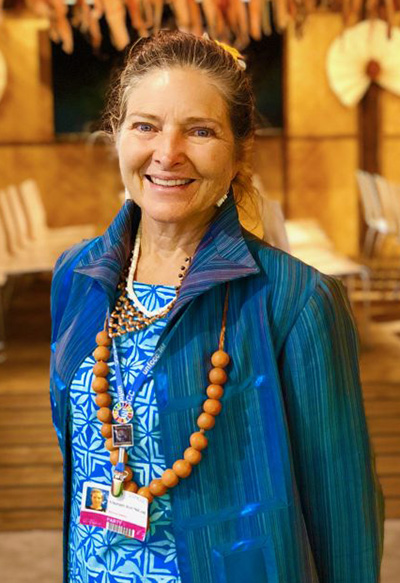
INTERVIEW FACT FILE:
Name: Elisabeth Holland
Position: Professor, University of the South Pacific, Fiji
Why: Holland is a renowned climate scientist. She has been a central figure in the international climate negotiations and has been a visiting scholar at the Bjerknes Center for Climate Research this year.
This article has been republished from the Norwegian ezine 2°C with permission.





